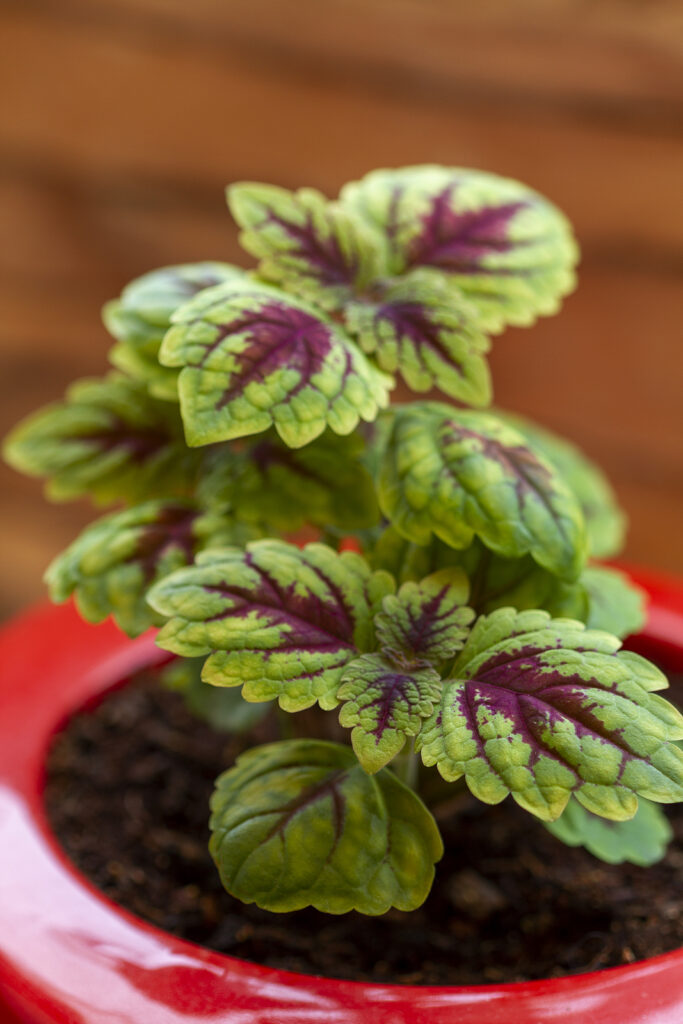Coleus are tender annuals or perennials with brilliantly variegated foliage which surpasses that of other garden plants for color. Leaves can be maroon, green, crimson, yellow, and combinations of these colors.
Coleus grows easily outdoors from late spring through summer in most regions. It grows best in full sun but will easily grow in partial shade. In very hot summer regions, it should be protected from the midday sun.
Coleus can be grown as a houseplant year-round everywhere. Indoors it needs bright light and average room temperatures to thrive. Pinching back leaves will keep the plant full.
Get to know Coleus
- Plant type: Tropical evergreen perennial grown as an annual
- Growing Zones and range: 10-11
- Hardiness: Tender; day 70°F (21°C); night 55°F (13°C)
- Height and width: 6 to 36 inches (15-91cm) tall, 12 to 36 inches (30-91cm) wide
- Foliage: Leaves can be maroon, green, crimson, yellow, and combinations of these colors.
- Folaige colors: Green, chartreuse, yellow, buff, salmon, orange, red, purple, and brown–often with several colors on each leaf.
- Flowers: Spikes of tiny lavender flowers are inconspicuous
- Bloom time: Blooms from time to time
- Uses: Houseplant, outdoors as a bedding plant or container annual
- Common name: Coleus
- Botanical name: Coleus, Also listed as Solemostemon scutellarioides
- Family, Lamiaceae
- Origin: Africa and East Indies
Where to plant Coleus
- Grow coleus indoors in a bright location.
- Give coleus full sun from a southern exposure to maintain bright foliage colors, but will adapt to eastern or western exposure,
- Does well under artificial light, needing 14 hours of light each day.
- Outdoors coleus grows best in partial shade; it is tolerant of full sun to deep shade.
- Outdoors plant coleus in humus-rich, well-drained soil. Indoors plant coleus in an all-purpose potting mix with good drainage.

When to plant Coleus
- Set coleus outdoors in late spring after the last frost when the ground has warmed.
Planting and spacing Coleus
- Space coleus 12 to 24 inches (30-61cm) apart.
How to water and feed Coleus
- Keep the soil evenly moist. Check daily as the plant may use a lot of water.
- Mist coleus daily; it grows best where humidity is 40 to 45 percent.
- Outdoors water when the soil feels dry 2 inches (5cm) below the surface.
- Fertilize coleus with a slow-release fertilizer or feed every two weeks with a mild liquid fertilizer.
Coleus care
- Mulch around coleus outdoors in summer.
- Remove flowers as they form to keep plant compact.
- If plants become leggy, take cuttings and begin again.
- Repot when roots occupy half of the pot space.
- Pinch away flower buds which drain the plant’s energy. Pinching flower buds will make the plant grow fuller.
- Let plants rest in winter; place them in a cool location at 55°F (13°C). Reduce water slightly and withhold fertilizer.
Growing Coleus as a houseplant
- Coleus requires bright light; it can also be grown under fluorescent light.
- Coleus needs average room temperature and high humidity.
- The soil should be kept evenly moist but not soggy.
- Fertilizer should be applied regularly in spring and summer.
Coleus pests and diseases
- Coleus is susceptible to attack by whiteflies and mealybugs.
Coleus propagation
- Start seeds indoors 10 weeks before the last frost; seeds germinate uncovered in 10 days at 70° to 75°F (21°-24°C)
- Cuttings root easily and grow quickly in water or in soil.
- Older plants with spindly foliage may be used for tip cuttings.
Coleus varieties to grow
- Bellevue Hybrid has leaves variously splashed with pink, red, ivory, and green.
- Dragon Series leaves are dark with combinations of purple, black, and red, and rimmed with gold.
- Coleus pumulis has smaller leaves and hanging stems than most coleus hybrids.
Also of interest:
How to Grow Solenostemon — Coleus















